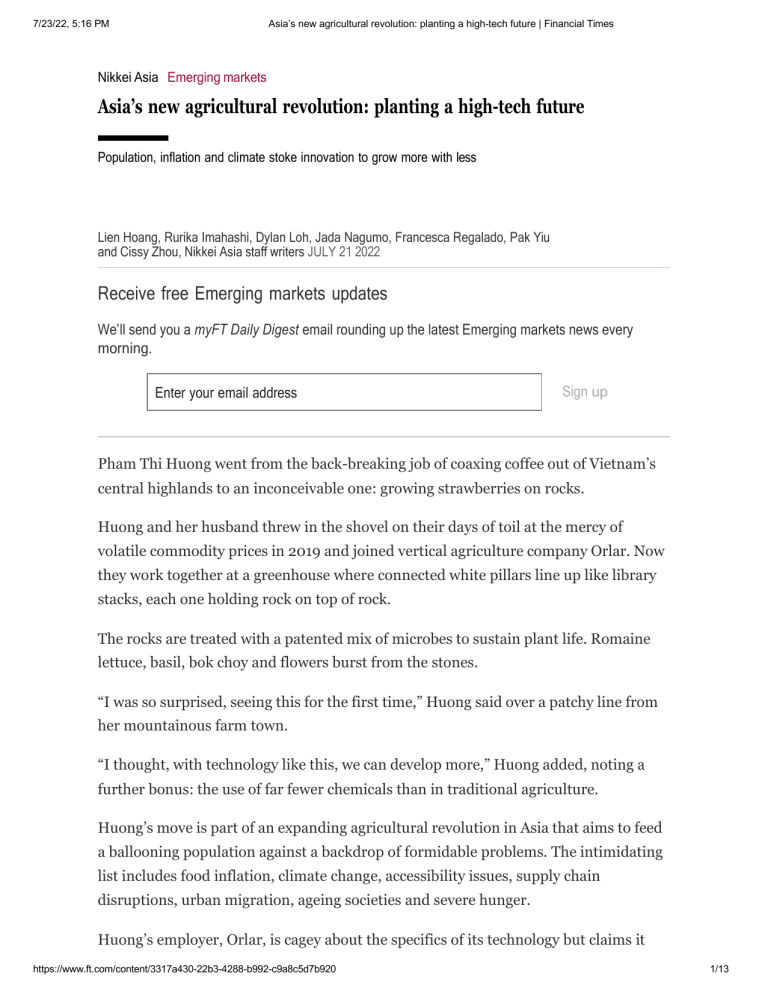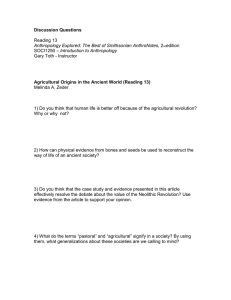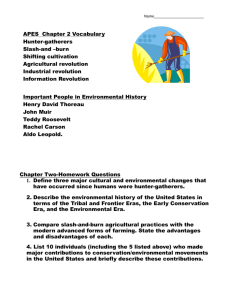
Asia’s new agricultural revolution: planting a high-tech future | Financial Times 7/23/22, 5:16 PM Nikkei Asia Emerging markets Asia’s new agricultural revolution: planting a high-tech future Population, inflation and climate stoke innovation to grow more with less Lien Hoang, Rurika Imahashi, Dylan Loh, Jada Nagumo, Francesca Regalado, Pak Yiu and Cissy Zhou, Nikkei Asia staff writers JULY 21 2022 Receive free Emerging markets updates We’ll send you a myFT Daily Digest email rounding up the latest Emerging markets news every morning. Enter your email address Sign up Pham Thi Huong went from the back-breaking job of coaxing coffee out of Vietnam’s central highlands to an inconceivable one: growing strawberries on rocks. Huong and her husband threw in the shovel on their days of toil at the mercy of volatile commodity prices in 2019 and joined vertical agriculture company Orlar. Now they work together at a greenhouse where connected white pillars line up like library stacks, each one holding rock on top of rock. The rocks are treated with a patented mix of microbes to sustain plant life. Romaine lettuce, basil, bok choy and flowers burst from the stones. “I was so surprised, seeing this for the first time,” Huong said over a patchy line from her mountainous farm town. “I thought, with technology like this, we can develop more,” Huong added, noting a further bonus: the use of far fewer chemicals than in traditional agriculture. Huong’s move is part of an expanding agricultural revolution in Asia that aims to feed a ballooning population against a backdrop of formidable problems. The intimidating list includes food inflation, climate change, accessibility issues, supply chain disruptions, urban migration, ageing societies and severe hunger. Huong’s employer, Orlar, is cagey about the specifics of its technology but claims it https://www.ft.com/content/3317a430-22b3-4288-b992-c9a8c5d7b920 1/13 7/23/22, 5:16 PM Asia’s new agricultural revolution: planting a high-tech future | Financial Times minimises the need for chemicals, energy, water and land. The start-up’s task is one faced by businesses and farmers across a world where the population is expanding but resources are not. To feed an increasingly hungry planet, Orlar and other new farming revolutionaries must produce more with less. Food prices have shot up across Asia, hitting their highest levels since 2011. Farmers face droughts and ice storms, rising costs of fertiliser and fuel, pandemic-related labour shortages, and supply chain disruptions exacerbated by Russia’s invasion of Ukraine. Strawberries grow out of rocks at Orlar’s vertical farm in Da Lat in Vietnam’s central highlands © courtesy of Orlar Prices are expected to keep rising. Meanwhile, Asia’s population is projected to surge by 700mn to 5.3bn in 2050. Last year, more than 1.1bn people lacked access to adequate food in this region alone. The billion-dollar question now is: how will the world’s most populous land mass feed itself in the decades to come? Across the region, companies are approaching this task by harnessing the power of technology. Some are disrupting thousands of years of traditional soil agriculture and breaking new ground, growing the food of our future on rocks, hydrogel sheets, Petri dishes and vertical racks. Others bring machine learning to agtech. https://www.ft.com/content/3317a430-22b3-4288-b992-c9a8c5d7b920 2/13 7/23/22, 5:16 PM Asia’s new agricultural revolution: planting a high-tech future | Financial Times In Japan, cherry-red robot tractors serve as new beasts of burden. In China, pigs are monitored by roaming cameras, and tomatoes are harvested by bots. From Philippine rice to Vietnamese shrimp, selective breeding is being applied to increase yields. Climate is being controlled in glasshouses, vertical farms and fish tanks. This article is from Nikkei Asia, a global publication with a uniquely Asian perspective on politics, the economy, business and international affairs. Our own correspondents and outside commentators from around the world share their views on Asia, while our Asia300 section provides in-depth coverage of 300 of the biggest and fastestgrowing listed companies from 11 economies outside Japan. Some technology, from tracking soil health to following a mango’s supply chain journey, is getting cheaper, says Patricia Sosrodjojo, partner at Seedstars International Ventures, an early-stage investor in emerging markets. But Sosrodjojo also warned that the “compounding” global issues of the past two years illustrate the need for more innovation. “People . . . realised there is this machinery that gets food to the market. And then things like Covid and the supply chain, [problems] Subscribe | Group subscriptions that could happen, did happen,” she said in an interview with Nikkei Asia. “It also serves as a wake-up call that these threats are real.” Many companies are investing in research to develop solutions for problems that are expected to spiral in the years to come. “Better prepare the cart now, then attach the horse later,” said Jauhar Ali of the International Rice Research Institute (IRRI), which has been preparing for food shortages by genetically modifying rice to optimise nutrition and yield. https://www.ft.com/content/3317a430-22b3-4288-b992-c9a8c5d7b920 3/13 7/23/22, 5:16 PM Asia’s new agricultural revolution: planting a high-tech future | Financial Times The agtech revolution could hardly be more pressing. Population growth is up but stockpiles are down, with reserves of staples shrinking for four straight years until just recently, according to the International Grains Council. Stocks of wheat, barley, maize, soyabeans and rice will drop to an eight-year low of 583mn metric tons in 2023, according to the intergovernmental organisation. A trifecta of problems has stoked food inflation: Covid, conflict and climate. Russia’s war in Ukraine has driven up costs, from animal feed to fertiliser. This has compounded the food insecurity unleashed by export bans, hoarding and supply chain bedlam during the pandemic. Global warming threatens to intensify the damage to crops caused by drought, floods, typhoons and pests. Agtech has the potential to be an integral part of an ecosystem of innovation that could mean fewer humans will go hungry. But its acolytes will need to overcome crucial impediments, such as high investment costs and energy scarcity, if it is to live up to its existential promises. Yanmar’s autonomous tractors plough a field in eastern Japan © courtesy of Yanmar In 2022 BC, farmers cultivated plants that suited their location. One could say the https://www.ft.com/content/3317a430-22b3-4288-b992-c9a8c5d7b920 4/13 7/23/22, 5:16 PM Asia’s new agricultural revolution: planting a high-tech future | Financial Times climate determined the crop. In 2022 AD, with farm tech, the crop determines the climate. Indoor farms are sheltered from rain, sunlight and heat. That gives humans what our ancestors might have seen as divine control over water levels, light and temperatures used to nourish the crops of their choosing. Chinese company Kaisheng Haofeng runs one of the planet’s biggest greenhouses, in the country with the most mouths to feed. It spreads across the area of 30 football pitches in rural Shandong province, where tomatoes are the star of the show. The company deploys an arsenal of Dutch machines that automate the fruit’s diet of water and fertiliser, calibrate light and ventilation, and kill bacteria with ultraviolet rays. Modern artificial microclimates enable horticulture year-round across the vast landscape of the nation of 1.4bn people. A researcher with the International Rice Research Institute in the Philippines clips samples of a hybrid variety of African rice © courtesy of International Rice Research Institute Kaisheng’s smart tech has raised yields sixfold. Old-school greenhouses, by contrast, do not “withstand harsh environments” too well, deputy general manager Li Ju-hai said, adding that they cannot produce the food https://www.ft.com/content/3317a430-22b3-4288-b992-c9a8c5d7b920 5/13 7/23/22, 5:16 PM Asia’s new agricultural revolution: planting a high-tech future | Financial Times quality that consumers demand. “My country is ushering in a new era of enhanced comprehension of consumption,” Li said. That is also the idea with Japan’s Mebiol, which claims it can grow food in barren places. Former Japanese astronaut Soichi Noguchi once took its flagship technology to space, and succeeded in growing herbs in zero gravity. Mebiol’s invention looks like hairy grass sprouting from a huge sheet of plastic wrap. It is a mix of nutrients and water in a hydrogel, which is then flattened into sheets fertile enough to sustain plants. As with Orlar’s rocks in Vietnam, cherry tomatoes and mizuna leaves spring from the see-through film, using no soil and minimal water. The global agtech market will reap $22.5bn in revenue by 2025, up from $9bn in 2020, according to UK-based Juniper Research. Tomatoes grow in a greenhouse in Kunming, Yunan province, China © courtesy of Ridder The numbers are attracting investment in agtech, which reached record highs last year as venture capitalists placed nearly $12.2bn in 632 deals, according to international trade association CropLife. In the first quarter of this year alone, investors have splashed 224 deals with $3.9bn. “Agtech 1.0 concentrated on areas like genetics, pesticides and fertilisation,” said Sanjeev Krishnan, founder and managing director at S2G Ventures, which invests in food and agriculture. https://www.ft.com/content/3317a430-22b3-4288-b992-c9a8c5d7b920 6/13 7/23/22, 5:16 PM Asia’s new agricultural revolution: planting a high-tech future | Financial Times “Agtech 2.0 focuses much more on digitisation, data science and alternative farming, which has helped respond to Covid and the issues it caused with supply disruptions and labour force access,” Krishnan added. “Something like digitalisation has become important because people need supply chain visibility, they want to know crop yield,” Krishnan said. Agtech is allowing farming to move off scarce land, into buildings and on to rooftops. This is particularly helpful in rich but densely populated countries like Singapore, which is about half the size of London and has less room for traditional agriculture. Singapore, which imports 90 per cent of its food, sees urban farming as a way to produce more at home and bolster supply security. It has designated more than 10 rooftops to grow more than 2,000 tons of vegetables every year. ComCrop, one of the city-state’s first rooftop farms, has been churning out mint and lettuce using hydroponics since 2011. It requires neither pesticides nor soil on this tiny island nation of 724 square kilometres. Tomatoes grow in a Kaisheng Haofeng greenhouse in Shandong province, China © courtesy of Ridder The government aims to grow 30 per cent of the island’s nutritional needs by 2030. The Singapore Food Agency has earmarked more than $40mn to create an agriculture industry that is resilient to climate and can use resources efficiently. The agency supports seafood businesses like Blue Ocean Aquaculture Technology, which rears jade perch and red tilapia in oxygen-rich tanks at a factory. https://www.ft.com/content/3317a430-22b3-4288-b992-c9a8c5d7b920 7/13 7/23/22, 5:16 PM Asia’s new agricultural revolution: planting a high-tech future | Financial Times Shrimp farmers from Thailand to Vietnam are taking a similar approach, shifting their crustaceans from outdoor ponds to indoor tanks. The controlled environment protects against plankton blooms and water pollution. Climate control may guard farms from mercurial weather — but it can come at a heavy cost to the wider biosphere. Sceptics say not every change in agriculture is progress. For indoor farms, a big problem is the “phenomenal” amount of energy consumed, acknowledges Orlar founder Lyndal Hugo. She argues that the rocks her company use act like thermal batteries, storing heat and reducing the need for external power. Mizuna leaves grow without soil on a thin hydrogel film developed by Mebiol © courtesy of Mebiol But vertical farms can be notoriously electricity-intensive. In one stark example, strawberries drained 3,000 per cent more power on a Russian vertical farm than a Chilean conventional one, scholars Paul Teng and Steve Kim wrote in an analysis for Singapore’s Nanyang Technological University blog last year. “Unless we remove energy from the system, we’re never going to fight climate change, we’re never going to fight food insecurity,” said Hugo, who is licensing her invention to partners in Indonesia, Malaysia, the Philippines and Thailand. https://www.ft.com/content/3317a430-22b3-4288-b992-c9a8c5d7b920 8/13 7/23/22, 5:16 PM Asia’s new agricultural revolution: planting a high-tech future | Financial Times As Asia’s middle class expands, the region is expected to account for half the global growth in poultry and beef consumption, and three-quarters of seafood demand by 2030, according to a report by the Asian Development Bank. By then, more than 60 per cent of cereal demand in the developing world will come from south and east Asia, the report said. To keep pace, food production will have to increase 60 to 70 per cent compared with a decade ago, the ADB research showed. And costs today are already setting records. Russia’s invasion of Ukraine, both big exporters of wheat and maize, drove previously-rising prices of staples including vegetable oils and cereals to record highs this year, according to the UN Food and Agriculture Organization’s annual Food Price Index. The index, which tracks monthly price changes in a basket of commonly traded food commodities, has climbed 23 per cent in the past 12 months alone, hovering around an all-time high reached in March. Brazilian spinach grows on the Tampines Hub rooftop farm in Singapore © Dylan Loh That has added to other contemporary obstacles to sourcing food. These include Covid-addled supply chains further strained by China’s pandemic lockdowns; extreme https://www.ft.com/content/3317a430-22b3-4288-b992-c9a8c5d7b920 9/13 7/23/22, 5:16 PM Asia’s new agricultural revolution: planting a high-tech future | Financial Times weather events worsened by climate change; and ageing and urbanising societies in which people are less likely to work the fields. This is an urgent problem in Japan, where 29 per cent of people are 65 or older, the highest rate in the world. The archipelago had 1.74mn farmer households in 2020, down 44 per cent from 2000, said the ministry of agriculture, forestry and fisheries. The shortage of human hands suggests one potential answer: introduce more mechanical ones. Japanese company Yanmar Agribusiness has developed a fleet of self-driving tractors that bring precision to ploughing and ridging. Their human overlords use tablets to map planned routes for the vehicles, which stop when their sensors detect people or objects nearby. This is an example of the big impact that information and communication technology (ICT) can have on time-honoured farming practices, said Yanmar’s executive engineering officer Shigemi Hidaka. “Our agricultural industry needs to become a smart industry by utilising technologies like ICT and data linkage,” he said. Indoor fish farming at Blue Ocean Aquaculture Technology’s factory in Singapore © courtesy of Singapore Food Agency A thousand miles west, China’s 21st-century farm hands include the company Sananbio’s conveyor system that automates seeding and transplanting. Kaisheng Haofeng, meanwhile, plans to populate its greenhouses with robots for harvesting and packaging in 2023. And in the country with the world’s biggest appetite for pork, Beijing-based Nxin is https://www.ft.com/content/3317a430-22b3-4288-b992-c9a8c5d7b920 10/13 7/23/22, 5:16 PM Asia’s new agricultural revolution: planting a high-tech future | Financial Times developing machine learning to monitor pigs. Voice recognition, for example, can determine if a sow is crushing a piglet. Roving hog cameras boost output by using software to assess weight, pregnancy and signs of disease. Elsewhere in Asia devices do what humans cannot, or augment what they can. Drones in India blast pesticides at locusts. Sensors collect field data all across the continent, from moisture in soil to salinity in rice paddies. Other methods are being deployed to improve yield and quality of rice, Asia’s waterintensive staple carbohydrate. Nepal and the Philippines are investing millions of dollars in hybrid rice, which scientists alter for a number of traits, like disease and drought resistance. Selective breeding is also used in animals, such as milk cows in Bangladesh. Genetic modification of rice is particularly useful in saving water. A kilogramme of rice needs anywhere between 3,000 and 5,000 litres of water, compared to 900 litres for a kilogramme of wheat and 500 litres for the same weight in potatoes. Some hybrid rice varieties require up to 30 per cent less water. Decreasing water use is crucial in vast swaths of south and east Asia, where humanity is heading towards a water crisis because of shrinking glaciers, depleted groundwater and severe droughts. https://www.ft.com/content/3317a430-22b3-4288-b992-c9a8c5d7b920 11/13 7/23/22, 5:16 PM Asia’s new agricultural revolution: planting a high-tech future | Financial Times The Philippines-based International Rice Research Institute said Manila was the first government to approve its Golden Rice, a strain loaded with vitamins to nourish more people for less. Ali, the institute’s head of hybrid rice tech research, said hurdles included the years of development needed, and a public wary of genetic modification. Filipino farmers opposed to Golden Rice said the modified plant would “poison our lands” and increase reliance on pesticides and herbicides. Elsewhere, technology is being used to alter the crop fields themselves. India and Thailand, the world’s biggest rice exporters, zap lasers at dry land to measure bumps that need to be flattened. This kind of levelling cuts water and fertiliser use by spreading them out evenly, raising rice harvests by 7 to 10 per cent, according to German aid agency GIZ. Supporters of the new agricultural revolution say they urgently need more investment — and efforts to bring down costs. For example, Yanmar acknowledges that the $72,000-plus price tag on its autonomous tractor puts it out of reach of smallholders. The International Rice Research Institute has an annual budget of nearly $62mn, and Ali says that raising the hybrid rice programme’s budget by even $1mn would reap multiples of that amount. Despite all its potential, agtech is in its infancy. And countries with younger populations will take longer to scale to digital operations as they reap their “demographic dividend”. India, for example, will add another 183mn people to the working age group of 15-64 years over the next three decades, according to UN data. The International Rice Research Institute conducts an optimisation trial for drought and salinity © courtesy of International Rice Research Institute https://www.ft.com/content/3317a430-22b3-4288-b992-c9a8c5d7b920 12/13 Asia’s new agricultural revolution: planting a high-tech future | Financial Times 7/23/22, 5:16 PM To succeed, the new agricultural revolution will need to show that its innovations can reinvent millennia-old classical farming to meet the urgent needs of an age of food crisis in a cost-efficient manner. Back in Vietnam, Orlar’s efforts to make soft fruits spring from rocks are a sign of the potentially transformative quality of the new agricultural revolution. Its founder Hugo puts the equation starkly: “It’s only a valid technology if it improves people’s lives.” A version of this article was first published by Nikkei Asia on July 15 ©2022 Nikkei Inc. All rights reserved. Related stories • India’s poorest scald as cooking oil prices soar • Hunger in Asia on the rise • Asia needs to brace for surging food prices • Asia’s food crisis: Ukraine war triggers chain reaction of shortages • ‘Food Nationalism’ worries rise after India, Malaysia ban exports Copy right The Financial Times Limited 2022. All rights reserved. https://www.ft.com/content/3317a430-22b3-4288-b992-c9a8c5d7b920 13/13



